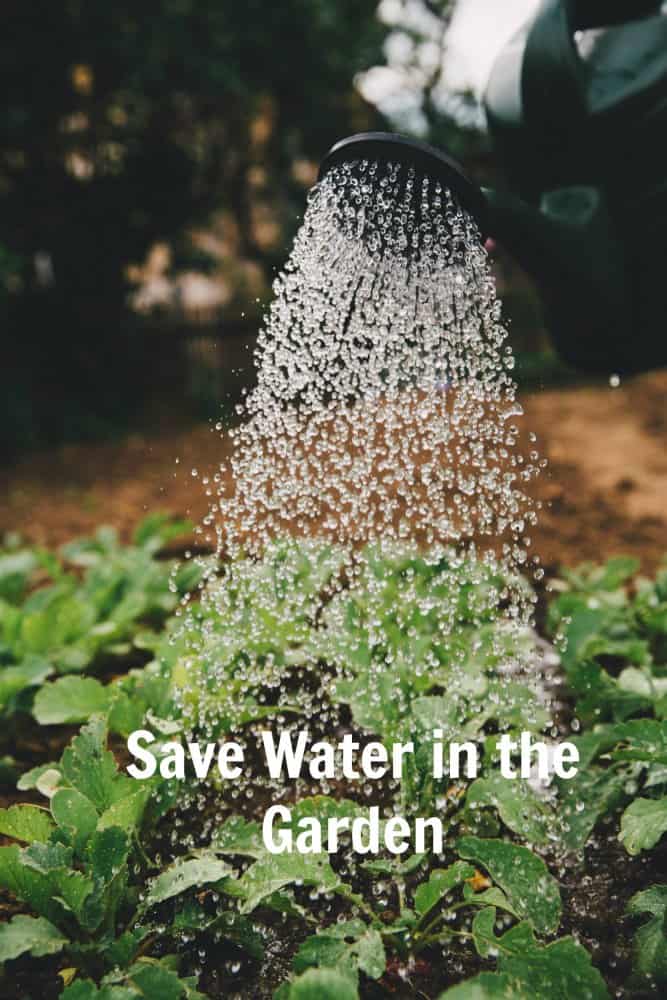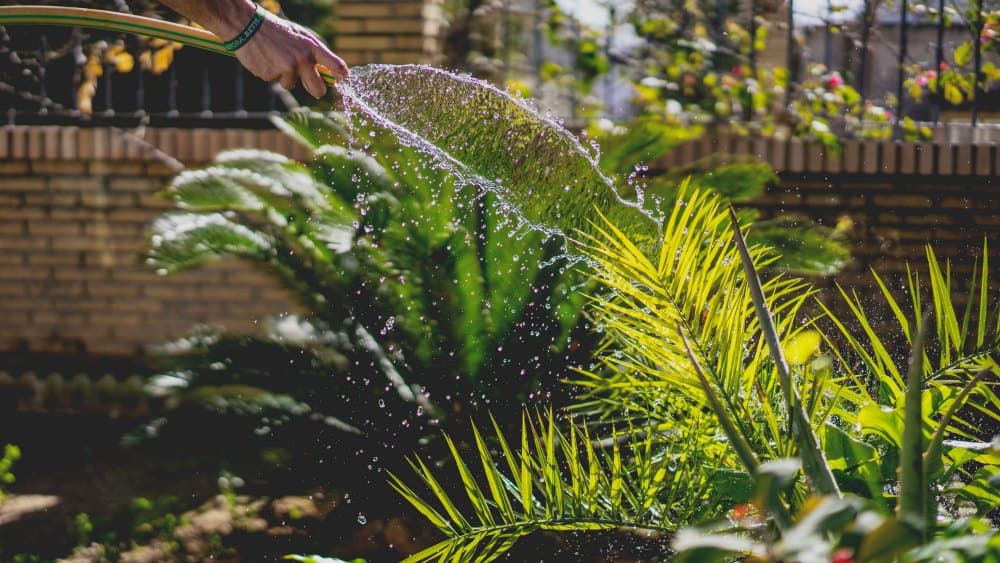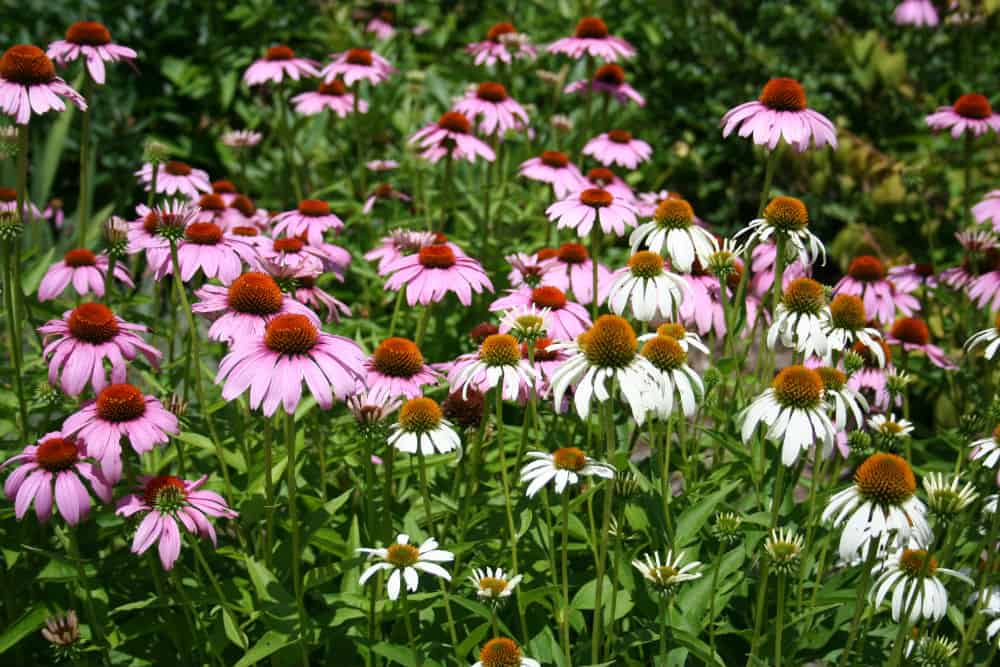Conserving water in the garden may not be the most exciting topic, but it’s an important one. Here, a look at how to save water.
Conserving Water in the Garden
This week we changed the irrigation sprinkler out in the vegetable garden for soaker hoses. We added soakers just to two beds, both tomato beds. The other plants got a little thunderstorm shower last night. What I was finding was that the heavy duty irrigation sprinkler – the kind that goes “ch-chc-chhhhhhhh” as it spins around and shoots water at you like a water cannon was also watering the grass between the garden beds. I don’t want to water the grass, just my vegetables. So we tried a little experiment with the soaker hoses and so far it seems to be working out just fine.
I did, however, manage to douse myself with our old soaker hose. We stopped using it in the garden in Long Island, and neither of us could remember why. Oh, I remember why now. It’s got some sort of crazy flaw; the last 7 feet don’t work and water doesn’t flow out of it, but it SHOOTS out of the tiny holes along the rest of the hose length. I made the mistake of standing over it while I turned on the spigot. Use your imagination. I looked like I wet myself. I may have too since I was laughing so hard…

Photo by Markus Spiske on Unsplash
The Importance of Conserving Water in the Garden
Water is a precious commodity and I never appreciated it until I moved to the country and we had to pay to install a water well. If the well runs dry or a problem develops, I also have to pay to fix it. Water doesn’t flow into the house when the electricity goes off, either. Conserving water in the garden is an important step to managing water resources.
Back on Long Island, if you lose the electricity in a hurricane, it didn’t matter, you still had flushing toilets and water to wash the dinner dishes. Not here. That’s why I keep a stockpile of bottled water in the house at all times and old plastic milk containers filled with water to use for other necessities. And if we heard of a snowstorm or hurricane coming, we have about half a dozen big pails that we fill with water and line up in the garage for toilet duty. Plus the creek out back, which in a pinch I could do the old-fashioned thing; haul water up to the house for the sanitary system should the need arise.
It’s all so important, yet we take running water for granted. Then you look at the news and the south, the big states that raise a lot of food such as Texas, Oklahoma and the like have such bad droughts that their farm wells are running dry and their creeks and ponds too.
Be Water Wise: Water Conservation in the Garden
Conserving water throughout the garden is an important aspect of organic gardening. Even conventional gardeners find that using techniques to save water and help the soil retain water for thirsty plants is a thrifty, frugal and smart way to garden. Gardeners in the city or suburban municipalities might not realize how important it is to conserve water if they’re on a citywide water system, where turning on the taps simply means water flows from a mysterious place and never ends.
Those living in a rural location or dependent on well water, however, know how critical it is to conserve water at all costs. Running wells dry to maintain flower gardens, vegetable gardens or green lawns isn’t just expensive – it’s foolish.
Techniques to keep rainwater in the ground near thirsty plant roots, save water for use later, or reduce plants’ needs for water work together to conserve water. Even planting native species and low-water-use flowers and shrubs add to an overall “water-wise” approach to gardening.

Photo by Irene Dávila on Unsplash
Choose Efficient Watering Methods
Most gardens require some form of supplemental watering, especially near newly planted trees, shrubs, and flowers. Consistent watering is the key to good growth and root development as well as flowering. Sprinklers and other watering systems can provide adequate water but many are overused or inefficient. The following suggestions offer more efficient options:
- Soaker hoses: Most sprinklers shoot water at the leaves of plants, yet plants absorb water through the roots growing under the soil. Soaker hoses provide a steady stream of water directly onto the soil. They look like regular garden hoses but have tiny holes punched along the length of the tubing. This sends water right into the thirsty soil, so instead of using extra water to spray the entire plant, you’re sending it directly to the roots. It’s great for vegetables and plants such as roses that are sensitive to too much water on the leaves.
- Sprinklers: If you use sprinklers, do not put them on a timer. Timers make it easier for the homeowner to keep up with watering but also send water to the garden on rainy days. Instead, use timers only when you’re away; manually turn on the water and use a kitchen timer to remind you when to turn it off.
- Hoses with multiple spray strength attachments: Garden hoses with spray nozzles that enable the homeowner to adjust the spray increase efficiency. You can change the strength from a solid, steady blasting stream to a gentle watering method. Always aim the hose at the roots of the plant. Don’t stand there waving a sprinkle of water over the leaves and think you’ve watered; all you’ve done is dusted the plant. Aim at the soil where the plant drinks and use the gentle setting. Allow time for water to soak into the soil.
- Dig a trench: Dig a shallow trench around vegetable plants such as peppers, eggplants and tomatoes. It doesn’t have to be deep. This creates a sort of pocket where water collects in puddles after watering or rain storms. As long as the soil isn’t pure clay and drains fairly well, this helps water plants more efficiently by collecting water and sending it down to the roots. It’s also a useful technique when planting trees.
Add Mulch to the Garden
Mulch helps plants conserve water and reduces watering needs in the garden in several ways. No matter what type of mulch you choose, mulch:
- Reduces the amount of water you need by preventing evaporation and keeping soil underneath moist
- Cools the plant’s roots, reducing the amount of water a plant needs
- Suppresses heat glare, which can increase temperatures around a plant
- Eliminates or suppresses weeds, which can take water away from the garden plants you want to grow
The type of mulch you choose is entirely up to you, and there are advantages and disadvantages to the many types of commercial mulch available.
- Wood chip and bark mulches provide a renewable source of organic material for the garden. They’re effective at retaining moisture, suppressing weeds, and keeping the ground moist and cool. However, they do break down rather quickly. By breaking down, they become organic matter that adds richness to the soil, but it also means you have to replace it more frequently than other types of mulch.
- Artificial mulch such as shredded rubber tires, glass mulch and other materials made from recycled products also offers both advantages and disadvantages. Homeowners like the clean appearance of artificial mulch and it works very well to retain moisture and cool the soil. It also last a long time – up to 20 years in some cases, depending on the type and brand of mulch. However, some artificial mulch has an unpleasant smell (think of the smell of hot tires at a truck stop). It also does not add any richness to the soil since it is made from inorganic materials.
One last note about mulch. Some types such as cocoa hull mulch as poisonous to dogs and cats, so if you have pets, read up on the type of mulch you are thinking of adding. Ask your pet’s veterinarian for information. Cocoa hull mulch is made from the discarded shells of cocoa beans, and the same compound that makes chocolate poisonous to pets is found in the shells. Curious pets can eat the mulch; it smells like chocolate or something sweet, and that’s often enough to entice an animal to nibble it. Do your research before installing it.

Echinacea “purpurea” and Echinacea “White Swan” in my garden.
Select Native Plants and Low Water Use Plants
Another technique to help the homeowner or gardener reduce and conserve water in the garden is to choose low water use plants and native plants for the landscape. Low water use plants are plants that naturally don’t need a lot of water. Sedum, for example, offers many ornamental uses in the garden and is a low water use plant, as are many succulents, cacti, and ornamental grasses. To find low water use plants, look at the tag on the pot in the garden center. Many stores such as Lowe’s Home Improvement Stores add a tag that sports a blue water droplet and the words “Water Wise” (or “Water Wyse”) on the tag, indicating that the plant requires minimal watering.
Native plants are those that have been hybridized or cultivated from plants that naturally grow in your gardening zone, state or region. Time and nature adapted them perfectly to the conditions of your garden, thus making them amenable to rainwater only and making supplemental watering unnecessary. Try selecting native plants whenever possible. Your local County Cooperative Extension office may have a list of local plant varieties available.

Save Whatever Whenever Possible
Although we might not think of it this way, water is a precious commodity. Save water whenever possible. Fix leaky faucets and reduce or eliminate timed sprinklers. Use a rain barrel, collecting the rainwater from your roof to use with a sprinkling or watering can to water pots. Add a saucer under planters to catch the extra water; allow the water to soak back into the pot. Dig a little trench around plants so that rainwater collects and waters them for longer periods of time. Add compost to the soil, which naturally balances clay and sandy soils alike and helps retain water. Lastly, plant native varieties and naturally low water use plants. You can still have a gorgeous garden even while saving the planet. Conserve water whenever possible and enjoy a beautiful garden.





Wow, just the title of the first book got me. I have to admit…I try to conserve water inside but am not so good outside. Go figure